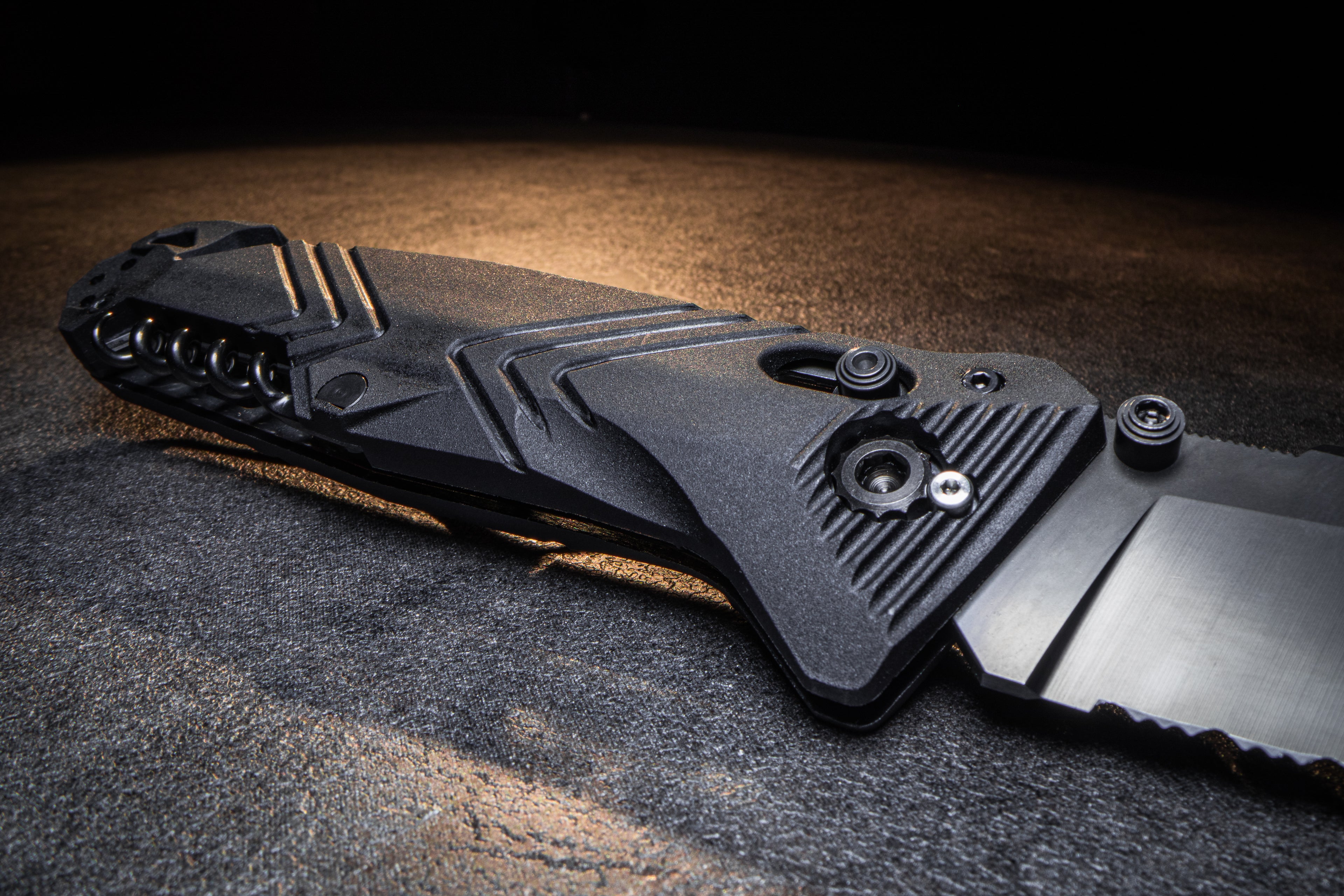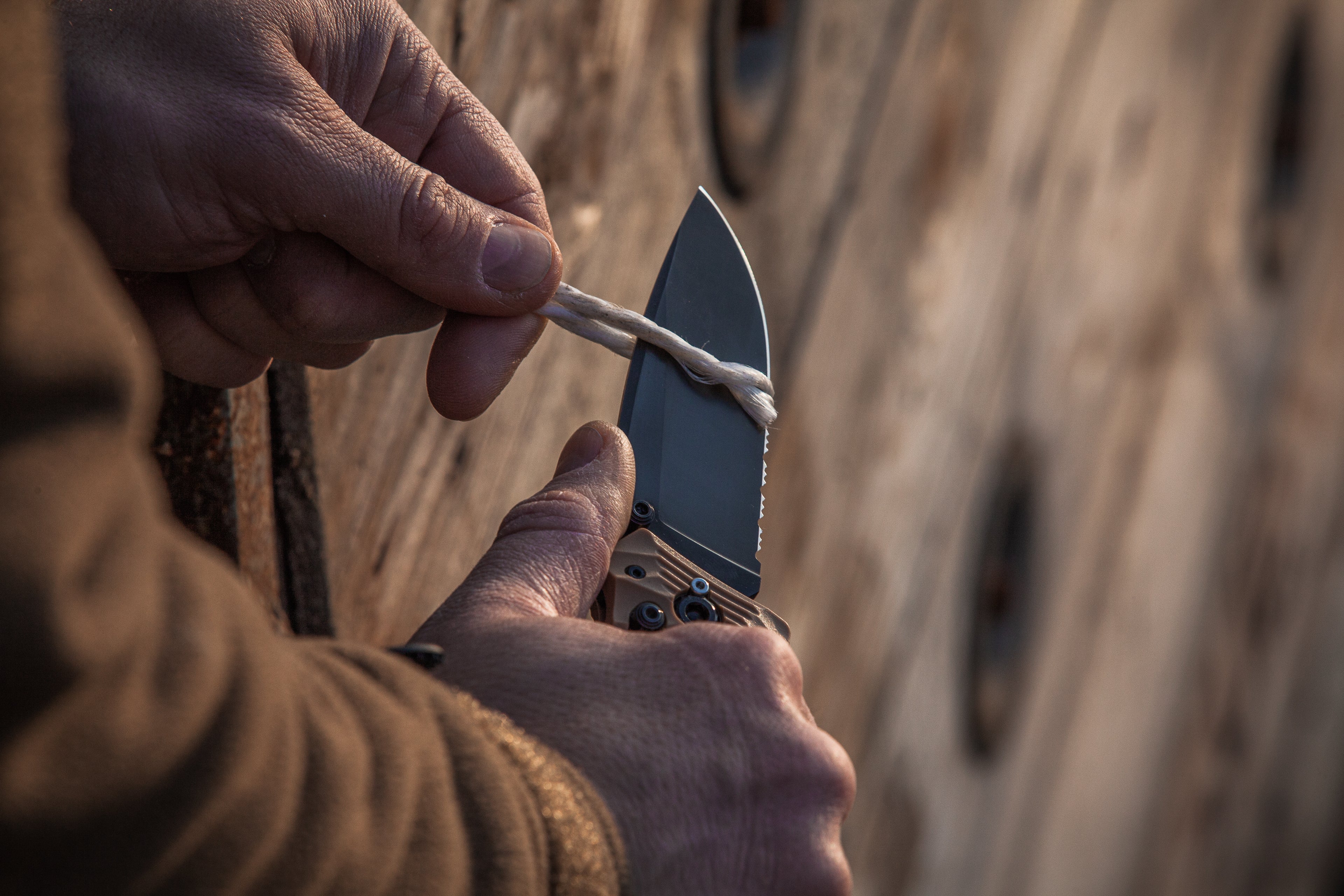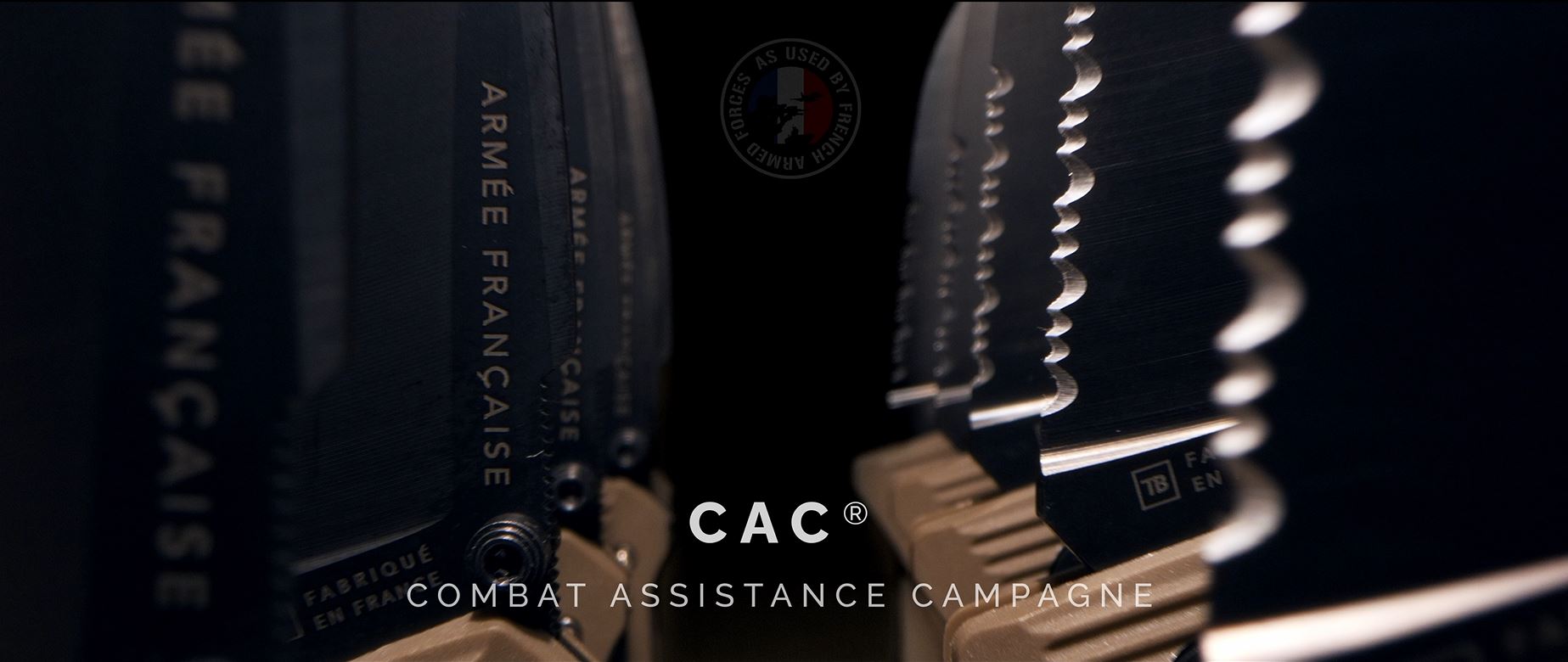History
The CAC®
This knife is our company's response to the request expressed by the French army, namely, to design a robust, ambidextrous knife that can be opened and closed with one hand.
The CAC® was officially selected against many competing products, for its performance , quality and price by the French army in 2017. Its distribution in the various army corps began in early 2018 and will largely equip our soldiers. at least until 2024.


Tightening
The blades are available in smooth or mixed blade (smooth + serrations)
belt clip
Reversible
Strap cutter
Share useful information about your product features.
Opening mechanism
Axis lock. Ambidextrous opening with one hand possible.
Sleeve
Different versions available. Toxified, chevron, PA6 FV or G10.
Window breaker
Tungsten carbide ball

Its variations
The CAC® is a multifunctional knife designed for maximum adaptability. Initially, we designed the knife with handle plates made of PA6, a polymer reinforced with glass fibers to improve its robustness. The PA6 FV has astonishing characteristics in terms of resistance to deformation and shock absorption, making it ideal for the most demanding conditions of use.
However, we have recognized our customers' interest in producing individually machined G10 sleeve inserts in solid blocks. G10 is a composite material based on fiberglass, impregnated with epoxy resin. This material is renowned for its high resistance to humidity, heat, chemicals, and for its exceptional dimensional stability.

Additionally, the versatility of the CAC® knife is enhanced by varied blade options, including fully smooth blades for a clean, precise cut, and blades with serrations for more aggressive work akin to sawing. Additional accessories, such as the strap cutter and corkscrew, can be added or removed from the configurations to tailor each knife to your specific needs!
In short, with more than 27 possible configurations of the CAC® knife, including different handle materials, blade types, colors and finishes, we are able to offer a tool truly adapted to everyone's requirements.

The CAC® blade
The CAC® blade is made of stainless steel doped with nitrogen, called Nitrox®. Featuring 16% chromium and a carbon content of 0.35%, Nitrox® is easy to sharpen and resists corrosion like few martensitic steels.
We also offer blade alternatives for sale, MOX® steel, Damascus steel among others.
Maintain your knife
Notice
TAKING CARE OF YOUR KNIFE
The NITROX® steel used for the blade has been specially selected for its ability to hold the cut, for its ease of resharpening and its high resistance to corrosion. Most of the metal parts of your knife, even if they are made of stainless steel, require preventive maintenance to avoid the appearance of corrosion. This is especially true if you use it in a humid or salty environment (seaside). The occasional application of clear oil is sufficient (for example that used for the maintenance of weapons). Occasionally, the belt clip screws may come loose, especially if you change the mounting direction of the clip (right/left). The application of thread lock on the screws, before tightening, is recommended (see supplier's instructions).
CURRENT OPERATIONS
The operating settings have been made at the factory and do not require modification on your part. However, some common operations require partial dismantling of the knife. The shiny stainless steel screws, all of the same size (hexagon key T 1.5), are the only ones that need to be operated to carry out the operations below. The other screws, black in color, should not be handled to carry out these operations or to maintain your knife.
SHARPENING
Regularly maintain the edge of your blade before it becomes too degraded. Maintain factory sharpening angles that ensure efficient cutting. There are a variety of products available to sharpen your knife. Choose the one with which you are most comfortable performing this operation.
NEVER SHARPEN YOUR BLADE ON A POWERED GRINDER.
The part with serrassions can be sharpened with the same accessories, but only on the side opposite to the serrassions.
AN EFFICIENT CUTTING TOOL
Your CAC® knife has been designed to be a real cutting tool. Never use your knife as a screwdriver, crowbar, wood chisel or awl. Its use for a function other than cutting can lead to irreversible damage.

Clean and lubricate
Always keep the mechanism area clean. The accumulation of dust and/or debris in this area can affect the operation of the blade locking mechanism. For effective cleaning, use warm soapy water, rinse thoroughly with hot water, then blow and dry the mechanism completely, ideally with compressed air. Finally, apply a greasy protective film. For optimum operation, regularly apply a drop of clear oil to the blade rotation axis.

Changing the direction of use of the belt clip
The CAC® knife is ambidextrous: In addition to the blade locking mechanism, which can be used by both right-handed and left-handed people, you can position the belt clip on the side of the knife that best suits your use. To reverse the belt clip mounting side, remove the 3 stainless steel screws (1). Position the belt clip (2) on the opposite side of the knife, then refit the 3 stainless steel screws (1). The application of thread lock on the screws, before tightening, is recommended to avoid any untimely unscrewing.

Replacing the strap cutter blade
If the belt clip (2) is mounted on the same side as the strap cutter (2), remove the 5 shiny stainless steel screws (1). Remove the belt clip (2) then remove the side of the handle (3). Replace the blade (4).
If the belt clip (2) is mounted on the same side as the corkscrew (3) remove only 2 shiny stainless steel screws (1). Remove dimension (3). Replace the blade (4). To reassemble your knife, proceed in the reverse order of the dismantling operations. The application of thread lock on the screws, before tightening, is recommended in order to avoid any untimely unscrewing.

Blade clearance adjustment
After many hours of use, it is possible that a slight lateral play may be felt at the blade axis. To guarantee impeccable operation in all circumstances, the adjustment of the blade axis (6) is “locked” by a specific shiny stainless steel locking screw (5). To adjust, remove the locking screw (5), then tighten or loosen the blade axle (6) as necessary. Lock this new adjustment by repositioning the locking screw (5) in one of the notches on the axle (6) provided for this purpose. Applying thread lock to the screws before tightening is recommended. Caution: excessive tightening of the axle (6) will prevent the blade from being maneuvered effectively. Prefer a “free” adjustment simply intended to compensate for lateral play.

